|
The Tōshōgū Shrine at Nikko was built in 1617 as a mausoleum
for the shogun Tokugawa Ieyasu, who put an end to the Sengoku civil war period
(1467–1568) and laid the foundation for the 250-year
period of peace leading up to the Meiji Restoration of 1868.
Having unified the country and established his
capital in Edo (modern Tokyo), Ieyasu continued to be concerned about the nation
even after his retirement. He died April 17, 1616, at the
age of 75. Just fifteen days before his death he left his closest associates
with the following will: “I wish to be buried on Mt. Kuno in Suruga [his
birthplace] and, after a year has passed, to be removed to Nikko. There my soul
may rest forever and become the tutelary deity of the Bakufu [Shogunate
Government].”
All was done in accordance with his
will. He had chosen Nikko because
it is north of Edo. The north was considered the taboo direction, inhabited by
demons. By placing himself there, he hoped to protect Japan from evil and ensure
long life for the Tokugawa government and eternal peace for the nation. When
enshrined at Nikko, Ieyasu was deified by the imperial court with the
spirit name of Tōshō
Daigongen (“Great Avatar Shining in the East” or “Incarnation of the Bodhisattwa
Illuminating the East”).
Although Ieyasu had requested “a small
shrine,” and this was what was initially built, the third shogun, Iemitsu (Ieyasu’s
grandson), almost completely destroyed the shrine and rebuilt it into today’s gorgeous
site. Most of the existing buildings were built during this period. Some 15,000
craftsmen were employed in its construction, most of them coming from Kyoto and
Nara, where there was a great flowering of architecture at that period. According to
contemporary expense reports, it cost roughly ¥55 billion (US$200 million) in today’s currency and
required 450,000 man-days over the course of one year and five months (November
1634 to April 1636) to complete the construction. The shrine complex contains
500 kg of gold and 370 kg of silver.
The building of Tōshōgū
represented the
climax of the Gongen-zukuri style of Japanese shrine
architecture; strictly speaking, this style (named for Tōshō
Daigongen) describes a shrine in which the honden (the sanctuary
inhabited by the enshrined spirit or kami) and the haiden (the
“oratory” or hall of worship) are joined by a passage called the
ishinoma (stone-floored room) to form an H shape. It should be noted,
however, that the term Gongen-zukuri is also sometimes extended to refer
to any shrine style characterized by elaborate ornamentation. Skills of the highest level available at the time were applied to
the architectural decoration of this shrine, especially in carving and coloring. Eight of the
buildings at the shrine have been designated as National Treasures, and an
additional 34 are Important Cultural Properties. For a splendid article on the
construction of Tōshōgū
and its master carpenter, Kohra Munehiro, visit
this site.
It should be noted that “Tōshōgū” is a
general term for a shrine devoted to Tokugawa Ieyasu (Tōshō
Daigongen); the Tōshōgū Shrine
at Nikko is merely the most celebrated and noteworthy example. The
“two shrines and a temple at Mount Nikko” inscribed on the
UNESCO World Heritage Site list in 1999 include, in addition to Tōshōgū, the
Futārasan Shrine (devoted to worship of the three sacred mountains at Nikko) and
the Rinnoji Temple, whose history dates back to 766.
The most notable aspect of the Tōshōgū
Shrine at Nikko is its carvings, which total 5,173. The most heavily carved
portion is undoubtedly the Yomeimon Gate, but the Karamon Gate alone has 611
carvings, 400
of which are flowers. each 7cm x 9cm.
During the Edo period there was a
saying, “Don’t say Kekko [magnificent] until you've seen Nikko.” To see the
Nikko Tōshōgū,
people traveled for four days on foot, finding Nikko magnificent indeed and
worshiping there. Today, tourists outnumber worshipers, but they still find it
magnificent.
As can be gathered from the photographs
that follow, we visited Tōshōgū
on a rainy day. I don’t recall that it was actually raining
while we were there, but it had rained earlier, and the ground was wet and
messy. To the best of my recollection, by the time we got to Tōshōgū,
I was beginning to feel I’d had a surfeit of temples and
shrines, and this one was too much to take in. There was a walk of some
considerable distance from the buses to the shrine entrance, with Kyoko talking
ninety to the dozen as usual, and I’m sure I missed quite a few vital points,
but I seem to recall being pretty unsure what I was looking at, and obviously I
wasn’t motivated to take very many pictures.
 Although
this plan is too small to be really readable, it does give a general impression
of the layout of the shrine grounds. One begins at the bottom with steps leading
to the stone torii, then proceeds up the path, through the Omote-mon into the
walled precinct, past numerous outbuildings to the Yomei-mon, and then through
the Kara-mon into the inner precinct (Honsha). Although
this plan is too small to be really readable, it does give a general impression
of the layout of the shrine grounds. One begins at the bottom with steps leading
to the stone torii, then proceeds up the path, through the Omote-mon into the
walled precinct, past numerous outbuildings to the Yomei-mon, and then through
the Kara-mon into the inner precinct (Honsha).
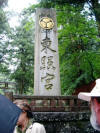 This
stele at the entrance to the site bears the chrysanthemum crest of the Tokugawa
family. This
stele at the entrance to the site bears the chrysanthemum crest of the Tokugawa
family.
 The
Ishidorii (Stone Torii) is one of only a few stone remnants of the
original 1618 shrine. It is 9.2 meters high and 13.2 meters wide, with pillars
of 3.6 meters in circumference. It is made of 15 blocks of stone, instead of
wood, which is the material usually used for torii. The center section bears
Ieyasu’s divine name, Tōshō
Daigongen. The
Ishidorii (Stone Torii) is one of only a few stone remnants of the
original 1618 shrine. It is 9.2 meters high and 13.2 meters wide, with pillars
of 3.6 meters in circumference. It is made of 15 blocks of stone, instead of
wood, which is the material usually used for torii. The center section bears
Ieyasu’s divine name, Tōshō
Daigongen.
The Ishidorii has a unique structure well designed to resist earthquakes; the
primary top rail (Kasagi) and the secondary top rail (Shimaki) are hollow in
order to minimize the weight, and a pair of grafted stone columns is set firmly
to support them. In fact, the crossbars shifted out of place in an earthquake in
1949 but were set back in place by an aftershock. The Ishidorii is one of the
three finest stone torii in Japan and is the largest made during the Edo period.
The stone steps leading up to the Ishidorii are ingeniously designed. Although
there are only ten steps, an impressive false perspective effect is created by
the fact that the staircase narrows toward the top, and the height of the steps
also decreases as they ascend. The tenth step contains the Terifuri-ishi or
weather forecast stone. When the color contrast between brown and blue becomes
stronger, it is a sign of bad weather to come.
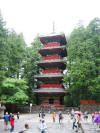 The
Gojūnotō
(Five-Storied Pagoda) is off to the left after you pass through the Ishidorii.
It was originally contributed by Tadakatsu Sakai, governor of Obama, in 1650. It
was destroyed by fire in 1815 and rebuilt in 1818 by a descendant of Tadakatsu.
The pagoda is 36 meters high and doesn’t actually have five stories in that
there are no floors inside. In order to make the tower stable enough to resist
wind and earthquake forces, the center pillar is suspended on the fourth story
and held 10 cm above the ground, thereby functioning as a dynamic counterweight
that maintains the center of gravity. The suspension also accommodates size
fluctuations due to changes in humidity. A bas-relief frieze on the first story
depicts the twelve signs of the zodiac and cardinal directions. The
Gojūnotō
(Five-Storied Pagoda) is off to the left after you pass through the Ishidorii.
It was originally contributed by Tadakatsu Sakai, governor of Obama, in 1650. It
was destroyed by fire in 1815 and rebuilt in 1818 by a descendant of Tadakatsu.
The pagoda is 36 meters high and doesn’t actually have five stories in that
there are no floors inside. In order to make the tower stable enough to resist
wind and earthquake forces, the center pillar is suspended on the fourth story
and held 10 cm above the ground, thereby functioning as a dynamic counterweight
that maintains the center of gravity. The suspension also accommodates size
fluctuations due to changes in humidity. A bas-relief frieze on the first story
depicts the twelve signs of the zodiac and cardinal directions.
 Entrance
to the walled shrine precinct is through the Omotemon (Front Gate),
originally called Niō-mon. The Niō are the
pair of Deva Kings who occupy the niches on either side. Under the Meiji
government, the Niō (who are guardians of Buddhism) were relocated to the
Taiyuin Mausoleum (part of Rinnoji Temple), and the gate was renamed Omotemon.
The Niō were restored in 1897. The 82 carvings on the gate include a Chinese
lion and a tapir; giraffes and tigers face the passage. The second tiger from
the right, instead of stripes, has spots like a leopard; during the Edo period,
the leopard was considered a female tiger. Entrance
to the walled shrine precinct is through the Omotemon (Front Gate),
originally called Niō-mon. The Niō are the
pair of Deva Kings who occupy the niches on either side. Under the Meiji
government, the Niō (who are guardians of Buddhism) were relocated to the
Taiyuin Mausoleum (part of Rinnoji Temple), and the gate was renamed Omotemon.
The Niō were restored in 1897. The 82 carvings on the gate include a Chinese
lion and a tapir; giraffes and tigers face the passage. The second tiger from
the right, instead of stripes, has spots like a leopard; during the Edo period,
the leopard was considered a female tiger.
 Niches
on the back of the Omotemon contain Chinese lions or Fu-dogs. Niches
on the back of the Omotemon contain Chinese lions or Fu-dogs.
 After
passing through the Omotemon, one comes to an L-shaped group of three sacred
warehouses (Sanjinko), which store 1,200 costumes for the Procession of a
Thousand Warriors (Sennin Musha Gyoretsu) that takes place each May
and October. The warehouses also store the equipment
for Yabusame (archery on horseback). The Sanjinko are open for viewing
for one week each before the Spring and Autumn Festivals. The warehouse pictured
here is the Upper Sacred Warehouse (Kamijinko). After
passing through the Omotemon, one comes to an L-shaped group of three sacred
warehouses (Sanjinko), which store 1,200 costumes for the Procession of a
Thousand Warriors (Sennin Musha Gyoretsu) that takes place each May
and October. The warehouses also store the equipment
for Yabusame (archery on horseback). The Sanjinko are open for viewing
for one week each before the Spring and Autumn Festivals. The warehouse pictured
here is the Upper Sacred Warehouse (Kamijinko).
 Carved
on the gable (pediment) of the Kamijinko are two elephants.
Because the chief painter, Tanyu Kano, had never seen real elephants, the ears
and tails of the animals are not anatomically correct; therefore the carvings
are referred to as Sōzōno-zō (“imaginary elephants”). Carved
on the gable (pediment) of the Kamijinko are two elephants.
Because the chief painter, Tanyu Kano, had never seen real elephants, the ears
and tails of the animals are not anatomically correct; therefore the carvings
are referred to as Sōzōno-zō (“imaginary elephants”).
 This
is the Shinkyu-sha (sacred stable). I didn't take this picture (I had to
steal it) because I was too busy trying to absorb what Kyoko was saying and
figure out whether or not she was joking when she explained that the horses were
not currently in residence (Kyoko was prone to little jokes, and this sounded a
lot like an excuse about a department store Santa’s
reindeer). I was relieved to learn that in fact horses are present in the
stable from 10 a.m. to 2 p.m. every day except when it is rainy or snowing.
Since we were clearly within the 10–2 window, presumably it
was the rain that kept them away. The sacred horses (two) must be white, and
these horses also participate in the biannual samurai-style 1,000-person
procession. I believe the stable also serves as a carriage house, housing
portable shrines used in processions. This
is the Shinkyu-sha (sacred stable). I didn't take this picture (I had to
steal it) because I was too busy trying to absorb what Kyoko was saying and
figure out whether or not she was joking when she explained that the horses were
not currently in residence (Kyoko was prone to little jokes, and this sounded a
lot like an excuse about a department store Santa’s
reindeer). I was relieved to learn that in fact horses are present in the
stable from 10 a.m. to 2 p.m. every day except when it is rainy or snowing.
Since we were clearly within the 10–2 window, presumably it
was the rain that kept them away. The sacred horses (two) must be white, and
these horses also participate in the biannual samurai-style 1,000-person
procession. I believe the stable also serves as a carriage house, housing
portable shrines used in processions.
 The
Shinkyu is unusual for Tōshōgū
in being unpainted except for a carved frieze. The frieze consists of eight
panels illustrating the life and education of a monkey. From early times,
monkeys were regarded as guardians of horses, conducive to their health, and
consequently it was customary until the Muromachi period to keep monkeys in the
stable. Kyoko told us that monkeys are still sacred in Nikko, protected by the
government, and are now (like the deer in Nara) a considerable nuisance,
stealing from residents’ kitchens, even taking food out of their refrigerators.The
most famous of the panels in the frieze is that of the San-saru (three monkeys).
The monkeys are taught in childhood to “see no evil, speak
no evil, and hear no evil,” a message that has been widely propagated (and
parodied) in many forms. The
Shinkyu is unusual for Tōshōgū
in being unpainted except for a carved frieze. The frieze consists of eight
panels illustrating the life and education of a monkey. From early times,
monkeys were regarded as guardians of horses, conducive to their health, and
consequently it was customary until the Muromachi period to keep monkeys in the
stable. Kyoko told us that monkeys are still sacred in Nikko, protected by the
government, and are now (like the deer in Nara) a considerable nuisance,
stealing from residents’ kitchens, even taking food out of their refrigerators.The
most famous of the panels in the frieze is that of the San-saru (three monkeys).
The monkeys are taught in childhood to “see no evil, speak
no evil, and hear no evil,” a message that has been widely propagated (and
parodied) in many forms.
 Approaching
the fabulous Yōmeimon, one passes through the Karadō-torii
(bronze gate), the first bronze torii in Japan. Shogun Iemitsu spent the
equivalent of ¥200 million in today’s currency for this gate. Curiously, a lotus
flower (a Buddhist symbol) is carved at the foot of the pillars. Approaching
the fabulous Yōmeimon, one passes through the Karadō-torii
(bronze gate), the first bronze torii in Japan. Shogun Iemitsu spent the
equivalent of ¥200 million in today’s currency for this gate. Curiously, a lotus
flower (a Buddhist symbol) is carved at the foot of the pillars.
 Jeff’s
shot of this approach gives a better overall view of the shrine. Jeff’s
shot of this approach gives a better overall view of the shrine.
 The
Yōmeimon (Sunlight Gate, so called because it faces
south) is named for one of the twelve gates in the imperial court in Kyoto. It
is also popularly called “Higurashi-no-mon” (Twilight Gate)
because a person can stand from dawn to dusk looking at all its carvings, of
which there are more than 500. Of these, 194 are carvings of 30 kinds of
imaginary or
mythical creatures, called reiju (holy or spiritual animals). Tanyu Kano and
Kano Yasunobu painted two dragons on the ceiling of the passage; one is going up
to the sky, the other coming down to the ground. The gate is 11.1 meters high, 7
meters wide, and 4.4 meters deep. In former times, common people were not
allowed to pass through this gate, and even imperial envoys were required to
change clothes before passing through. The
Yōmeimon (Sunlight Gate, so called because it faces
south) is named for one of the twelve gates in the imperial court in Kyoto. It
is also popularly called “Higurashi-no-mon” (Twilight Gate)
because a person can stand from dawn to dusk looking at all its carvings, of
which there are more than 500. Of these, 194 are carvings of 30 kinds of
imaginary or
mythical creatures, called reiju (holy or spiritual animals). Tanyu Kano and
Kano Yasunobu painted two dragons on the ceiling of the passage; one is going up
to the sky, the other coming down to the ground. The gate is 11.1 meters high, 7
meters wide, and 4.4 meters deep. In former times, common people were not
allowed to pass through this gate, and even imperial envoys were required to
change clothes before passing through.
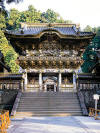 The
Yōmeimon (seen here on a sunny day) is generally regarded as the pièce
de résistance of Tōshōgū
and is designated as a National Treasure. Built in 1636, it has been maintained
through repeated roofing and painting repair to keep it in a condition equal to
that at the time of original construction, including its decorative sculpture
and other decorative members. It is the most elegantly decorated among the
shrine buildings of Tōshōgū.
Its 508 carvings were created by some 130,000 craftsmen with an unlimited
budget. But it is not perfect: in order to avoid angering the gods with the
presumption of perfection, one of the gate’s twelve white columns is
deliberately placed upside-down; this is called mayoke-no-sakabashira
(evil-averting inverted pillar). The
Yōmeimon (seen here on a sunny day) is generally regarded as the pièce
de résistance of Tōshōgū
and is designated as a National Treasure. Built in 1636, it has been maintained
through repeated roofing and painting repair to keep it in a condition equal to
that at the time of original construction, including its decorative sculpture
and other decorative members. It is the most elegantly decorated among the
shrine buildings of Tōshōgū.
Its 508 carvings were created by some 130,000 craftsmen with an unlimited
budget. But it is not perfect: in order to avoid angering the gods with the
presumption of perfection, one of the gate’s twelve white columns is
deliberately placed upside-down; this is called mayoke-no-sakabashira
(evil-averting inverted pillar).
 This
model of the Yōmeimon was created in the nineteenth
century and exhibited at the Japan British Exhibition in 1910 at the Great
White City, Shepherd's Bush, London. It has been restored and is now part of the
collection of the Victoria and Albert Museum in London. This
model of the Yōmeimon was created in the nineteenth
century and exhibited at the Japan British Exhibition in 1910 at the Great
White City, Shepherd's Bush, London. It has been restored and is now part of the
collection of the Victoria and Albert Museum in London.
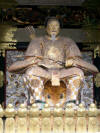 This
statue of Toyotomi Hideyoshi, a daimyo of the Sengoku
civil war era who unified Japan, also the builder of Osaka Castle, occupies the
right (east) side of the Yōmeimon. This
statue of Toyotomi Hideyoshi, a daimyo of the Sengoku
civil war era who unified Japan, also the builder of Osaka Castle, occupies the
right (east) side of the Yōmeimon.
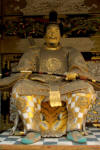 The
other (west) niche is occupied by a figure representing Yoritomo Minamoto, the founder of
the Kamakura Shogunate in 1192. The
other (west) niche is occupied by a figure representing Yoritomo Minamoto, the founder of
the Kamakura Shogunate in 1192.
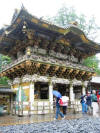 As
in the Omotemon, the niches on the back side of the gate contain Chinese lions or Fu-dogs. As
in the Omotemon, the niches on the back side of the gate contain Chinese lions or Fu-dogs.
 The
Karamon (Chinese Gate) is a small treasure, painted with white powder. The
pillars are decorated with dragons, while the upper side of the gate has
carvings of characters from the Chinese legend “The Seven
Sages of the Bamboo Grove.” The crane logo once used by Japan Airlines was
derived from one of the carvings on this gate. Although the gate is small, it is
the entrance to the most important building, the Honsha (Main Shrine). During
the Edo period, only feudal lords or aristocrats were admitted. Even today, only
guests of the nation can enter during important festivals. The
Karamon (Chinese Gate) is a small treasure, painted with white powder. The
pillars are decorated with dragons, while the upper side of the gate has
carvings of characters from the Chinese legend “The Seven
Sages of the Bamboo Grove.” The crane logo once used by Japan Airlines was
derived from one of the carvings on this gate. Although the gate is small, it is
the entrance to the most important building, the Honsha (Main Shrine). During
the Edo period, only feudal lords or aristocrats were admitted. Even today, only
guests of the nation can enter during important festivals.
 Jeff’s
wide-angle photo gives a better idea of the buildings in the Honsha behind the
Karamon. Jeff’s
wide-angle photo gives a better idea of the buildings in the Honsha behind the
Karamon.
 I
snapped this picture as we were leaving Tōshōgū,
just because I thought the bright red building was so pretty. For months I searched
futilely for information about what it was, finding no such building pictured at
any site about Tōshōgū
or indicated on any plan of Tōshōgū.
Finally by chance I learned that it is the Sanbutsodō (Hall of Three Buddhas) of
the Rinnoji Temple.
The history of Rinnoji dates back to 766, when Priest Shoto, the founder of
Nikko mountain worship, built Shihonryuji
Temple near the Shinkyo Sacred Bridge.
This
temple prospered as a mecca of mountain worshippers coming in large numbers for
religious training. Rinnoji became an important religious center following the
death of Ieyasu Tokugawa and the construction of Tōshōgū
Shrine. I
snapped this picture as we were leaving Tōshōgū,
just because I thought the bright red building was so pretty. For months I searched
futilely for information about what it was, finding no such building pictured at
any site about Tōshōgū
or indicated on any plan of Tōshōgū.
Finally by chance I learned that it is the Sanbutsodō (Hall of Three Buddhas) of
the Rinnoji Temple.
The history of Rinnoji dates back to 766, when Priest Shoto, the founder of
Nikko mountain worship, built Shihonryuji
Temple near the Shinkyo Sacred Bridge.
This
temple prospered as a mecca of mountain worshippers coming in large numbers for
religious training. Rinnoji became an important religious center following the
death of Ieyasu Tokugawa and the construction of Tōshōgū
Shrine.
Note that much of the information above was taken from a
Nikko Tourist
Association site. It is entirely possible that my translation of the English
on its pages is faulty.
| 